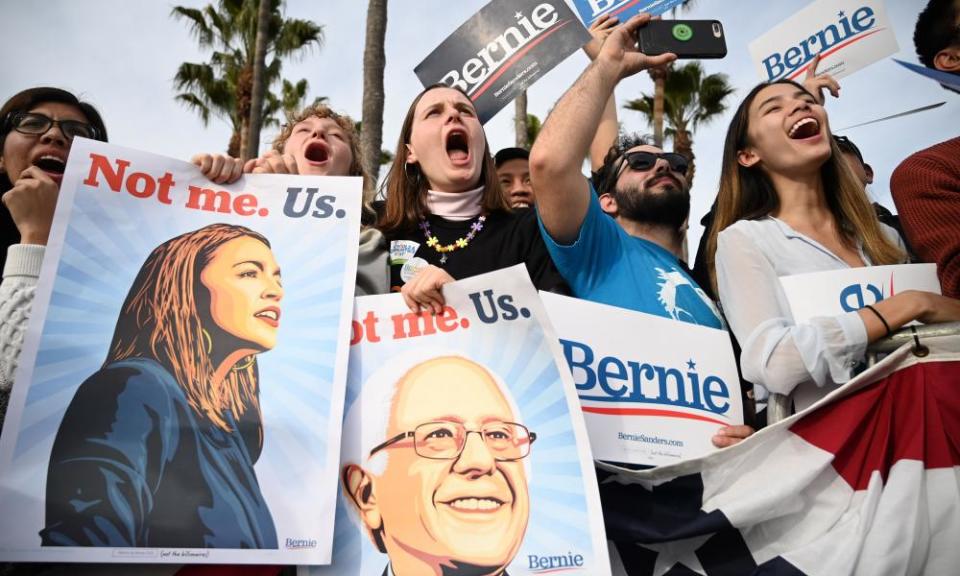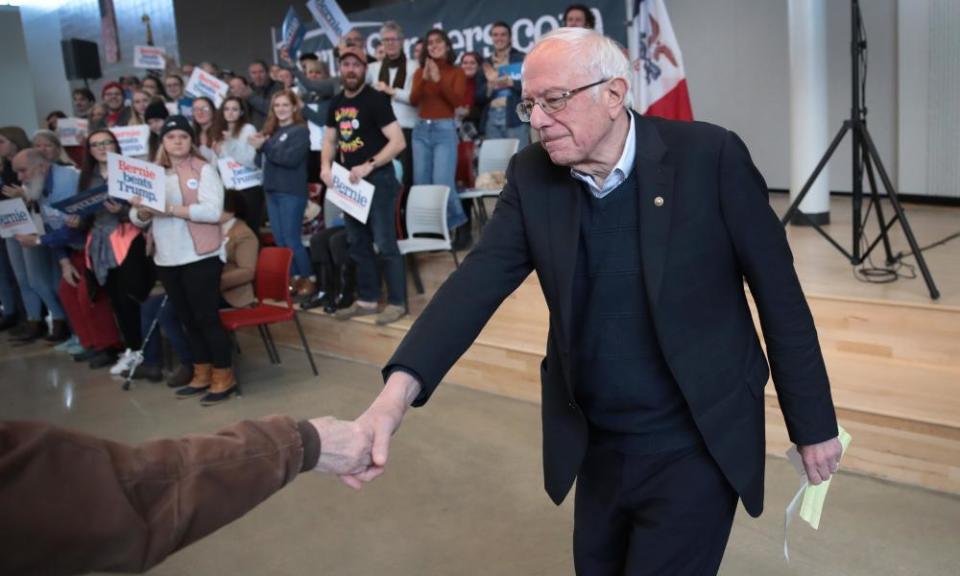Bernie Sanders surges in Democratic field after shrugging off health scare
Shortly after Bernie Sanders announced early this month that his campaign raised a showstopping $34.5m – the highest sum of any 2020 Democrat during any single quarter so far in this primary – #PresidentSanders was trending on Twitter.
It was an extraordinary reversal of fortunes for a presidential candidate who, three months earlier, was in a Las Vegas hospital recovering from a heart attack. At the time, Sanders was under immense political pressure, eclipsed by fellow progressive Elizabeth Warren and counted out by many in the party and by the president.
The episode might have derailed Sanders’ second quest for the White House had it not been for his army of loyal supporters, whose abiding faith turned the Vermont senator into a formidable contender for the Democratic nomination.
With less than four weeks until voting begins and the next debate looming on Tuesday, Sanders is surging in Iowa and New Hampshire as his campaign touts new signs of growth in his support, particularly among young people of color.
Even Larry David, the comedian who impersonates Sanders with striking likeness on Saturday Night Live, has been surprised by his doppelganger’s resilience.
“I thought when he had the heart attack that was going to be it – I wouldn’t have to fly in from Los Angeles,” David told late-night host Stephen Colbert. “But, you know, he’s indestructible. Nothing stops this man.”
Perhaps, but Sanders would not be where he is in the final weeks before the Iowa caucuses without the unwavering support of a devoted community that he has cultivated since running for president in 2016. “Not me. Us” – Sanders’ campaign slogan – perfectly captures how the 78-year-old senator came to sit atop the latest Des Moines Register and CNN poll of Iowa caucusgoers in a primary contest that has so far been shaped by candidates who are younger, more diverse and newer to national politics.
In the days and weeks after Sanders’ hospitalization, an outpouring of concern and well wishes turned into a record wave of campaign donations that culminated in a “Bernie is back” rally in Queens featuring Alexandria Ocasio-Cortez, the New York congresswoman who traces her political rise to Sanders’ 2016 campaign. There, she formally endorsed him in front of more than 20,000 ardent supporters.
“The heart attack was in some ways the best thing that happened to his campaign,” said Ana Maria Archila, the co-executive director of the Center for Popular Democracy, a coalition of progressive groups that endorsed Sanders in December.
She said it turned out to be a clarifying moment for his supporters, with Ocasio-Cortez’s endorsement serving as a literal rallying cry.
“Bernie has built a movement that makes people believe a different kind of politics is possible,” she said. “So when he came back, everyone wanted him to feel the love.”
In surveys, Sanders supporters are significantly more loyal to him than those backing any other 2020 Democrat. They are more likely to say they will definitely vote for him and that they are “enthusiastic” about his candidacy.
Their unshakeable support means that unlike many of his rivals Sanders may have the resources to stay in the race for months after the early-voting contests. Many Democrats fear he won’t exit the race even if he doesn’t have the delegates to win the nomination, dragging out the primary contest, weakening the eventual nominee and possibly even setting up a dramatic showdown at the party’s convention in Milwaukee.
Sanders has said he would support the nominee.
Sanders’ movement – coupled with a massive fundraising operation – sustained him through a potentially debilitating period of his campaign and lifted him higher still.
More than any other Democratic campaign, his supporters are highly organized online. They share stories, polling and memes across hundreds of pro-Sanders Facebook groups. And this cycle, his campaign launched its own mobile app, Bern, and its own email newsletter, Bern Notice, that keeps his supporters engaged and up to date with news from the trail.
“These tools are not as effective for persuasion,” said Michael Slaby, the Obama campaign’s chief technology officer in 2008 and chief integration and innovation officer in 2012. “If you’re an undecided voter you’re probably not tuning in to watch Sanders’ Twitch channel. But in terms of his ability to withstand challenges, it is really valuable to have that durable hard support.”
•••
Now an emboldened Sanders is sharpening his case for the presidency, tapping his deep financial resources to launch a large-scale advertising campaign in Iowa. He’s also become increasingly critical of his closest rival, Joe Biden, the putative Democratic frontrunner who has proved resilient at the top of the splintered field despite sustained attacks and self-inflicted gaffes.
In interviews and on the trail, Sanders has emphasized his longstanding aversion to war in response to the escalation of tensions with Iran. It’s part of a wider strategy to undermine the core rationale for Biden’s candidacy: that he’s the most electable. In particular, the senator has aggressively criticized Biden for his 2003 vote to authorize the invasion of Iraq and his past support for foreign trade deals.
Biden has mostly brushed off Sanders’ broadsides, though that could change in the next debate on 14 January, the last before the caucuses.
He has also quietly started to target Warren, a fellow liberal and a friend whom he had refused to engage publicly.

A script obtained by Politico instructed Sanders’ volunteers to tell voters wavering between the two liberals that Warren’s popularity was limited to the affluent and highly educated and that she was “bringing no new bases into the Democratic party” – a criticism meant to raise doubts about her electability.
Her campaign responded in a fundraising letter on Sunday: “This type of attack isn’t about disagreeing on issues – it’s about dismissing the potency of our grassroots movement.”
Sanders’ potential for victory, meanwhile, has stirred panic among establishment-minded Democrats. They see a candidate who entered the race with all the advantages of a frontrunner – near-universal name recognition, a prodigious fundraising operation and a message that still draws large, enthusiastic crowds – and yet has faced little scrutiny and relatively few attacks from his rivals.
In recent weeks, many moderate Democrats have urged Sanders’ rivals to challenge his case for electability.
In 2018, progressive candidates largely failed to prove they could build winning coalitions in swing districts and states. Many of the moderate House candidates who swept the Democrats to power by winning in Republican-held districts face tough re-elections and believe a Sanders nomination could jeopardize their majority, including a group of influential freshmen who recently endorsed Biden.
A memo circulated by the centrist Third Way warns that nominating Sanders would result in “electoral carnage” on a scale not seen since 1984, when Ronald Reagan beat Walter Mondale by the widest electoral college margin in presidential history. Mondale carried only his home state of Minnesota and the District of Columbia.
Sanders’ team balks at such analysis, which they believes ignores more recent history. Hillary Clinton’s loss to Trump in 2016, they say, was the cost of playing it safe.
A recent Fox News poll found Sanders defeating Trump by nearly the same margin as Biden in Wisconsin, perhaps the most critical 2020 battleground.
To win, Sanders’ campaign says he must expand the electorate by turning out a coalition of people who vote infrequently or have never voted before, including young, working-class and minority voters. Sanders’ campaign knows it must do better, particularly among black voters, a critical Democratic constituency that prefers Biden by wide margins.

But his team argues that they are making progress. New polling has him running close behind Biden in Nevada, the first state with a large Hispanic electorate to vote in the primary. And he is leading the field in California, a state with a large Hispanic electorate that is also the largest prize of the Democratic nominating contests.
And last quarter his campaign said it added 300,000 new donors and marked another milestone: it received more than 5 million donations, setting a new record for presidential candidates at this stage in the cycle.
In the final weeks before the Iowa caucuses, Biden has started to consolidate support from establishment Democrats while Warren has started pitching herself as the candidate best positioned to unite a divided party.
Unlike his rivals, Sanders must overcome deep skepticism from Democrats who still harbor reservations about his commitment to the party after years of agitating for change from the outside. Many Democrats who supported Clinton in 2016 still resent Sanders for dragging out the primary race and, in their view, not doing enough to help unify the party when the bitter contest was over.
“Sanders has shown that he can fire up his base,” said Sean McElwee, the executive director of the liberal polling firm Data For Progress. “What he needs to show now is that he can persuade people to vote for him who right now are supporting Warren or Biden. He still needs to prove to Democrats that he can represent them and the party in a general election. That’s the big turn that he needs to make.”

